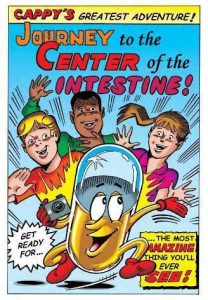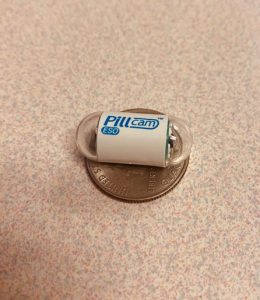This post is also available in:
Español (Spanish)
Français (French)
What is capsule endoscopy?
A capsule endoscopy is a simple test which your doctor may consider doing to look for bleeding or other conditions in the small intestine that cannot be investigated with a standard endoscope.
The standard endoscope (upper scope) can only reach to the first part of the small intestine. The standard colonoscope (lower scope) can only reach the last part of the small intestine. Much of the small intestine is unable to be evaluated on the standard endoscopy procedures, which is why the capsule endoscopy plays an important role.
The capsule is the size of a large pill and contains a small light and camera that takes pictures as it passes through the small and large intestines. It is either swallowed by the child or placed endoscopically. No sedation is needed if the capsule can be swallowed. Talk with your doctor to determine if your child can swallow the capsule or if it will need to be placed endoscopically, with sedation.
Why is capsule endoscopy used and what can it find?
Capsule endoscopy is used most often to look for a source of bleeding in the GI tract when nothing was identified on upper or lower endoscopy. Video capsule studies can also identify areas of inflammation, blood vessel collections (vascular malformations i.e arteriovenous malformations (AVM’s, ulcers, and can help diagnose Crohn’s disease, celiac disease, tumors, and polyposis syndromes.
How big is the capsule?
The capsule is the size of a large vitamin or pill and measures approximately 2.6 cm x 1.1 cm.
What is a patency capsule?
The patency capsule is a dissolvable capsule (without a camera or light inside), that is swallowed or placed endoscopically before the real capsule is given. It is the same size as the real capsule.
A patency capsule can be given first to ensure there are no narrowed areas or strictures in the small intestine where the pill can get stuck.
The patency capsule’s outer coating is biodegradable; made with a sugar coating and a small amount of barium. A small amount of barium is used so the patency capsule can show up on an x-ray image.
The patency capsule dissolves approximately 30 hours after ingestion, so if the child or parent does not see the patency capsule pass within 24 hours, an x-ray can be done to identify its location in the GI tract.
How long does it take the capsule to pass?
The capsule endoscopy procedure typically takes 8 hours.
How do I prepare my child for the capsule endoscopy procedure?
Each hospital will have specific instructions that may vary slightly, so we recommend speaking with your doctor’s office for their instructions. In general:
- For the patency capsule,
- Medications: the doctor will recommend taking several laxative doses the evening prior to the study
- Diet: nothing to eat or drink for several hours before and after the study. The doctor’s office will give you specific instructions on timing for eating certain foods/liquids.
- Capsule Swallowing: you’ll need to come to your doctor’s office for your child to swallow the pill. This should take about 30 minutes.
- Imaging: An x-ray will need to be obtained if you or your child have not seen the capsule pass in the stool after 24 hours. This x-ray will help visualize where the capsule is in the GI tract. The timing of the x-ray is important, as the patency capsule can dissolve after 30 hours.
- For the real capsule,
- Medications: the doctor will recommend taking several laxative doses the evening prior to the study. Sometimes simethicone is given prior to the study.
- Diet: nothing to eat or drink for several hours before and after the study. The doctor’s office will give you specific instructions on timing for eating certain foods/liquids.
- Capsule Swallowing: you’ll need to come to your doctor’s office for your child to swallow the pill & be fitted with a belt. The recorder on the belt captures the image data from the pill and records it.
- Recorder/Belt Return: The recorder and belt will need to be turned back into your doctor’s office so the data can be downloaded. The doctor’s office will tell you when to return the recorder and belt.
- Imaging: If you or your child do not see the capsule pass in the stool after several days, then an x-ray will need to be obtained. If abdominal pain, bloating, nausea, or vomiting occur, your child will likely need an x-ray and evaluation by a doctor.
What happens after the capsule is placed?
Your child will wear a data recorder worn on a belt. Your doctor’s office will tell you instructions on when and how to return the data recorder and belt.
Your child will be able to drink clear liquids after 2 hours and eat a light meal 4 hours after capsule ingestion.
Once you return the recorder and belt back to the doctor’s office, the data will then be downloaded, and each image will be reviewed by your physician. This can take time, as there are typically hundreds of pictures taken and need to be reviewed. Capsule endoscopy results should be ready in 1-2 weeks.
Are there any risks to capsule endoscopy?
Although it is a very safe procedure, the capsule can sometimes get stuck in the small intestine and could need surgery to remove it. This risk is very low if prior imaging and/or a patency capsule has already been done. Signs of obstruction may include bloating, nausea, vomiting, abdominal pain.
Will the capsule endoscopy hurt?
No, the capsule endoscopy is painless as it passes through the digestive tract.
Do I need to retrieve the capsule after it passes in my child’s stool?
No, neither the patency capsule nor the real capsule needs to be collected from the stool. Allow it to flush down the toilet.
How do I educate my child about capsule endoscopy?
After reviewing the procedure details with your doctor’s office, we recommend an open discussion with your child, so they know what to expect during the procedure.
There are helpful videos & booklets below to also review with your child to put them at ease.
Informative Videos
You can help put your child at ease about an upcoming endoscopy through the following step-by-step video guide:
Informative Comic Strip

Author: Laurie McCann, DO - Children’s Mercy Hospital, Kansas City, Missouri; Christine Waasdorp Hurtado, MD – Childrens Hospital Colorado, Colorado Springs, CO.
Editor: Christine Waasdorp Hurtado, MD – Childrens Hospital Colorado, Colorado Springs, CO.
May 2023
This post is also available in:
Español (Spanish)
Français (French)





